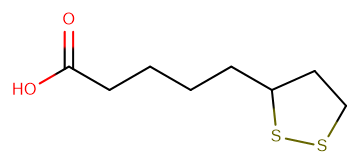
Thioctic acid
CAS No. 1077-28-7
Thioctic acid( Thioctic Acid )
Catalog No. M10312 CAS No. 1077-28-7
THIOOCTIC ACID, a natural product, is reported to have antioxidative property.
Purity : >98% (HPLC)
 COA
COA
 Datasheet
Datasheet
 HNMR
HNMR
 HPLC
HPLC
 MSDS
MSDS
 Handing Instructions
Handing Instructions
| Size | Price / USD | Stock | Quantity |
| 500MG | 45 | In Stock |


|
| 1G | Get Quote | In Stock |


|
Biological Information
-
Product NameThioctic acid
-
NoteResearch use only, not for human use.
-
Brief DescriptionTHIOOCTIC ACID, a natural product, is reported to have antioxidative property.
-
DescriptionTHIOOCTIC ACID, a natural product, is reported to have antioxidative property.(In Vitro):The long terminal repeat (LTR) of HIV-1 is the target of cellular transcription factors such as NF-κB, and serves as the promoter-enhancer for the viral genome when integrated in host DNA. α-Lipoic Acid (Alpha-Lipoic acid, ALA), a naturally occurring dithiol compound, plays an essential role in mitochondrial bioenergetics. α-Lipoic Acid reduces lipid accumulation in the liver by regulating the transcriptional factors SREBP-1, FoxO1, and Nrf2, and their downstream lipogenic targets via the activation of the SIRT1/LKB1/AMPK pathway. Treatment of cells with α-Lipoic Acid (250, 500 and 1000 μM) significantly increases the NAD+/NADH ratio in HepG2 cells (P<0.05 or P<0.01). Treatment with α-Lipoic Acid (50, 125, 250 and 500 μM) increases SIRT1 activity in HepG2 cells. α-Lipoic Acid (50, 125, 250, 500 and 1000 μM) increases phosphorylation of AMPK and acetyl-CoA carboxylase (ACC) in HepG2 cells in a dose-dependent fashion.(In Vivo):C57BL/6J mice, divided into four groups, are fed an high-fat diet (HFD) for 24 weeks to induce nonalcoholic fatty liver disease (NAFLD) followed by daily administration of α-Lipoic Acid. Then, the effects of α-Lipoic Acid on hepatic lipid accumulation in long-term HFD-fed mice are assessed. Administration of α-Lipoic Acid (100 mg/kg or 200 mg/kg) markedly reduces visceral fat mass in mice. In addition, α-Lipoic Acid (100 mg/kg or 200 mg/kg) treatment inhibits the appetite and causes a dramatic weight loss (all P<0.05).
-
In VitroThe long terminal repeat (LTR) of HIV-1 is the target of cellular transcription factors such as NF-κB, and serves as the promoter-enhancer for the viral genome when integrated in host DNA. α-Lipoic Acid (Alpha-Lipoic acid, ALA), a naturally occurring dithiol compound, plays an essential role in mitochondrial bioenergetics. α-Lipoic Acid reduces lipid accumulation in the liver by regulating the transcriptional factors SREBP-1, FoxO1, and Nrf2, and their downstream lipogenic targets via the activation of the SIRT1/LKB1/AMPK pathway. Treatment of cells with α-Lipoic Acid (250, 500 and 1000 μM) significantly increases the NAD+/NADH ratio in HepG2 cells (P<0.05 or P<0.01). Treatment with α-Lipoic Acid (50, 125, 250 and 500 μM) increases SIRT1 activity in HepG2 cells. α-Lipoic Acid (50, 125, 250, 500 and 1000 μM) increases phosphorylation of AMPK and acetyl-CoA carboxylase (ACC) in HepG2 cells in a dose-dependent fashion.
-
In VivoC57BL/6J mice, divided into four groups, are fed an high-fat diet (HFD) for 24 weeks to induce nonalcoholic fatty liver disease (NAFLD) followed by daily administration of α-Lipoic Acid. Then, the effects of α-Lipoic Acid on hepatic lipid accumulation in long-term HFD-fed mice are assessed. Administration of α-Lipoic Acid (100 mg/kg or 200 mg/kg) markedly reduces visceral fat mass in mice. In addition, α-Lipoic Acid (100 mg/kg or 200 mg/kg) treatment inhibits the appetite and causes a dramatic weight loss (all P<0.05).
-
SynonymsThioctic Acid
-
PathwayOthers
-
TargetOther Targets
-
RecptorMultivitamin uptake inhibitor
-
Research AreaOther Indications
-
Indication——
Chemical Information
-
CAS Number1077-28-7
-
Formula Weight206.33
-
Molecular FormulaC8H14O2S2
-
Purity>98% (HPLC)
-
SolubilityDMSO: 10 mM
-
SMILESOC(=O)CCCCC1CCSS1
-
Chemical Name——
Shipping & Storage Information
-
Storage(-20℃)
-
ShippingWith Ice Pack
-
Stability≥ 2 years
Reference
1.Ning-Ping Foo, et al. Toxicology Volume 282, Issues 1–2, 28 March 2011, Pages 39–46
molnova catalog



related products
-
2-Di-1-ASP
2-Di-1-ASP is a mono-stryryl dye and widely used as mitochondrial stain and groove-binding fluorescent probes for double-stranded DNA.
-
Ribostamycin sulfate
Ribostamycin is a broad-spectrum antimicrobial, inhibits bacterial protein synthesis at the level of 30S and 50S ribosomal subunit binding, also inhibits the chaperone activity of protein disulfide isomerase (PDI), used in pharmacokinetic and nephrotoxicity studies.
-
Coniine hydrochlorid...
Coniine hydrochloride, a polyketide-derived alkaloid, is poisonous to humans and animals.



 Cart
Cart
 sales@molnova.com
sales@molnova.com


